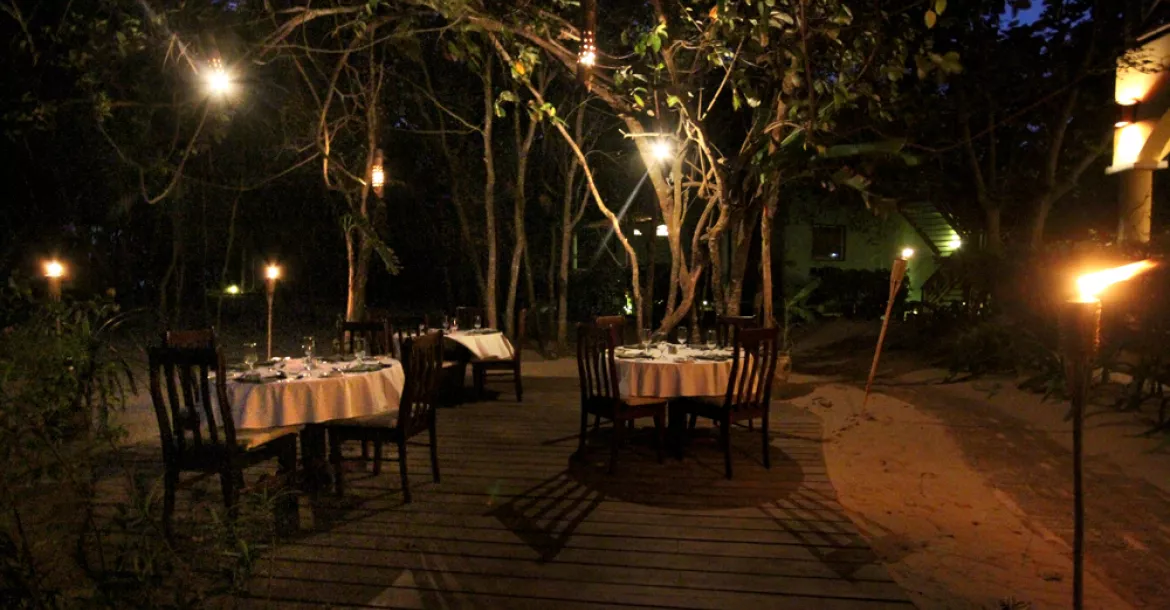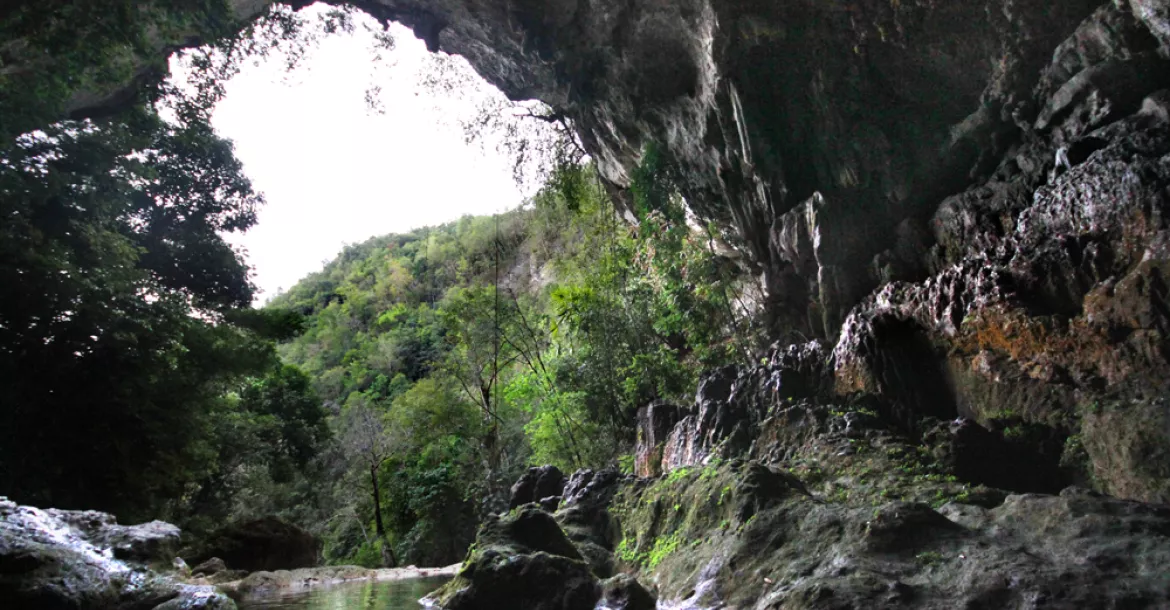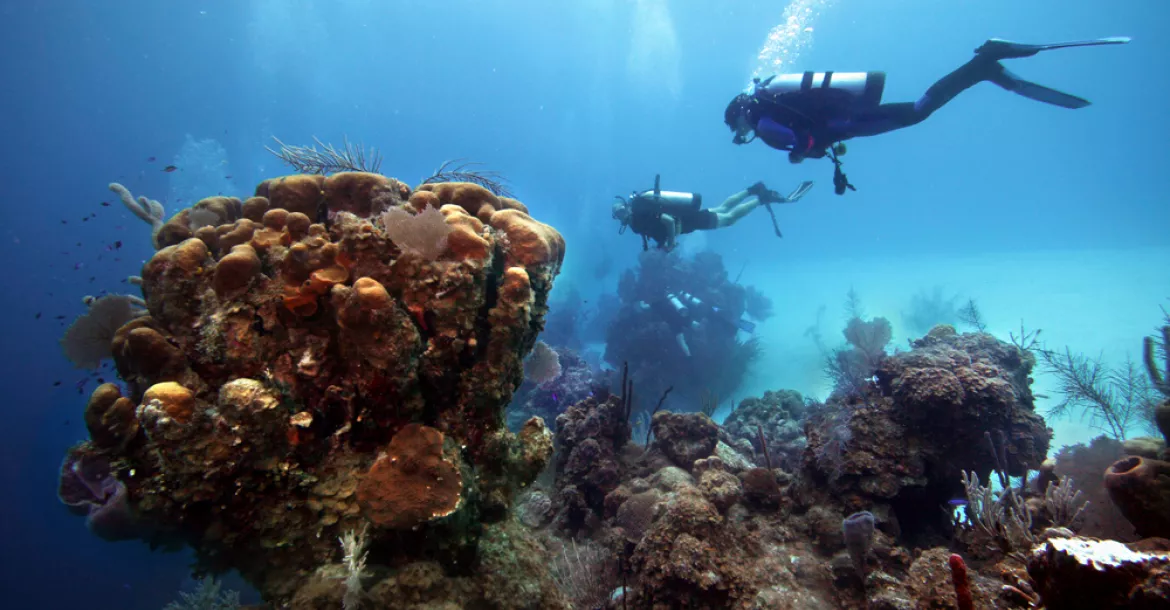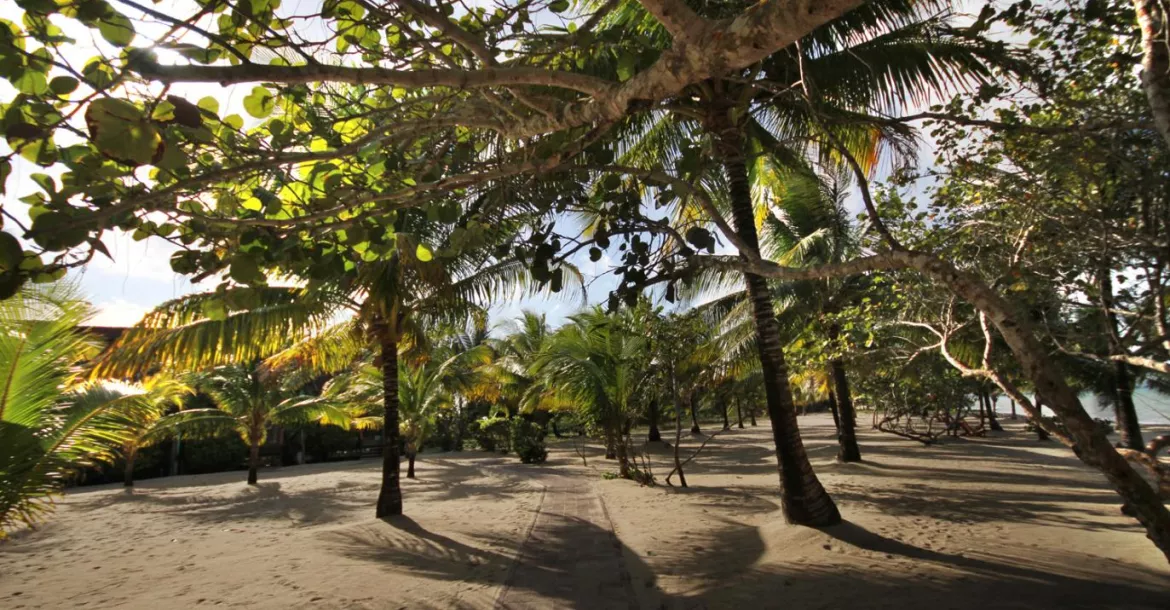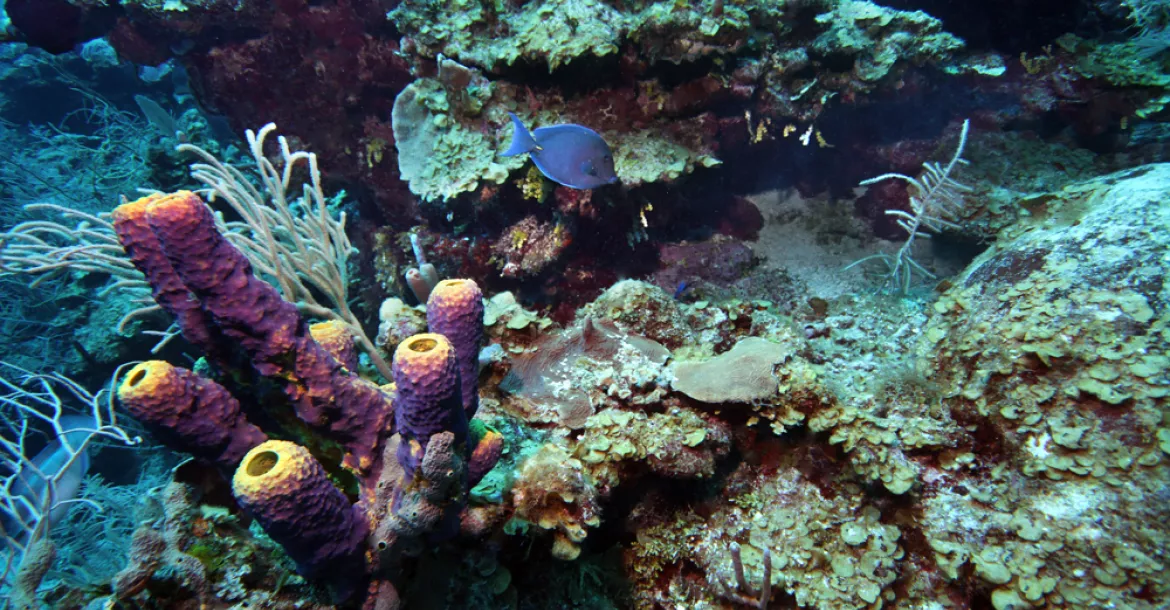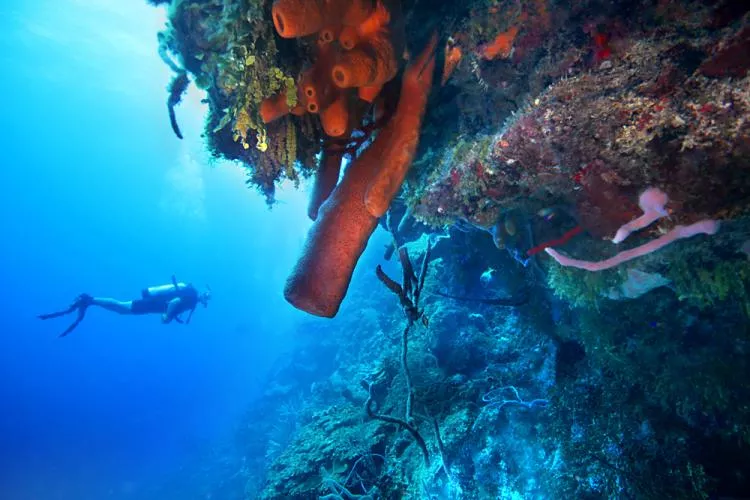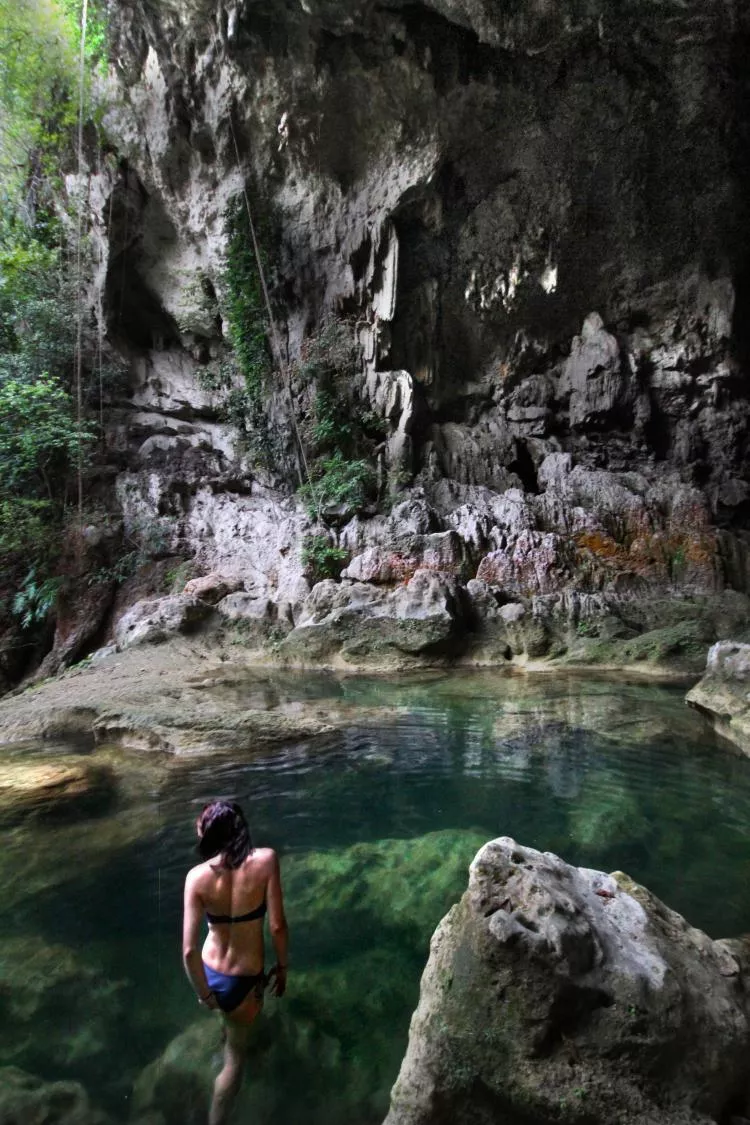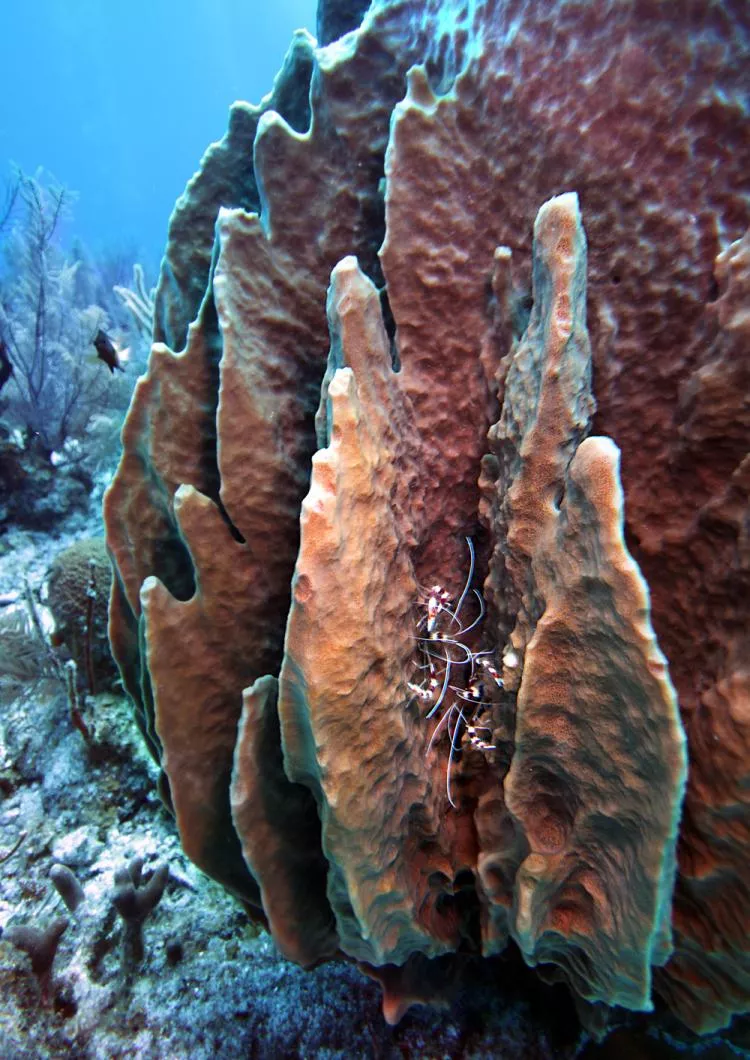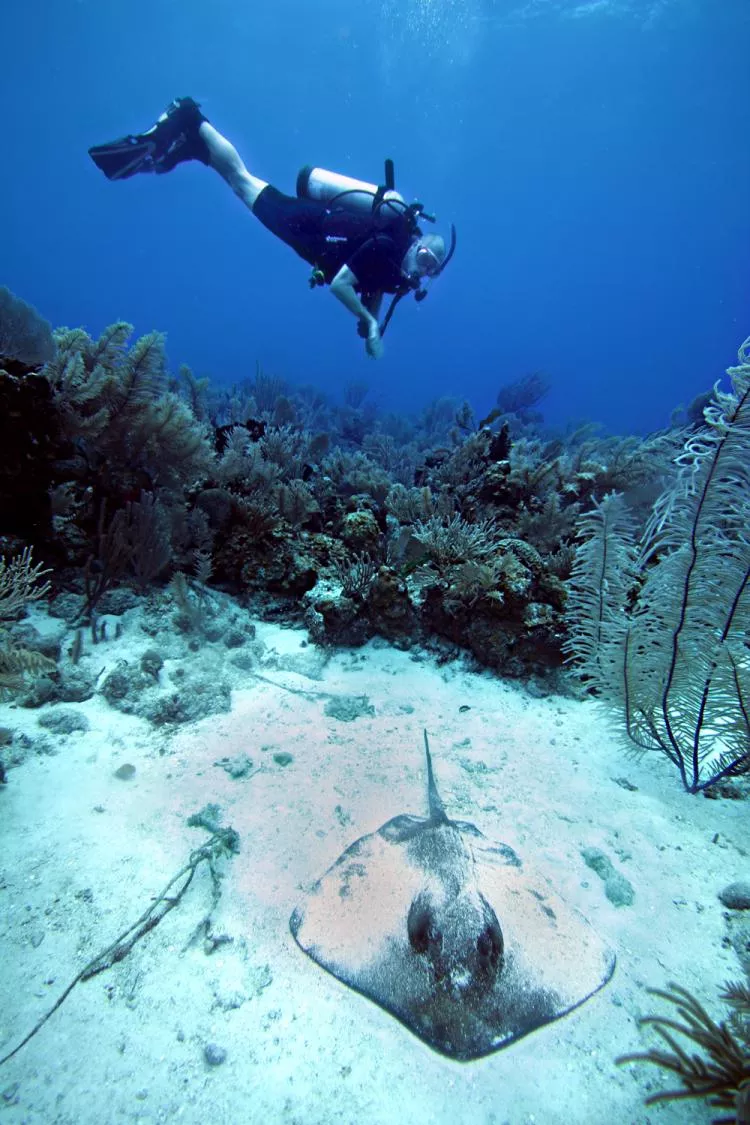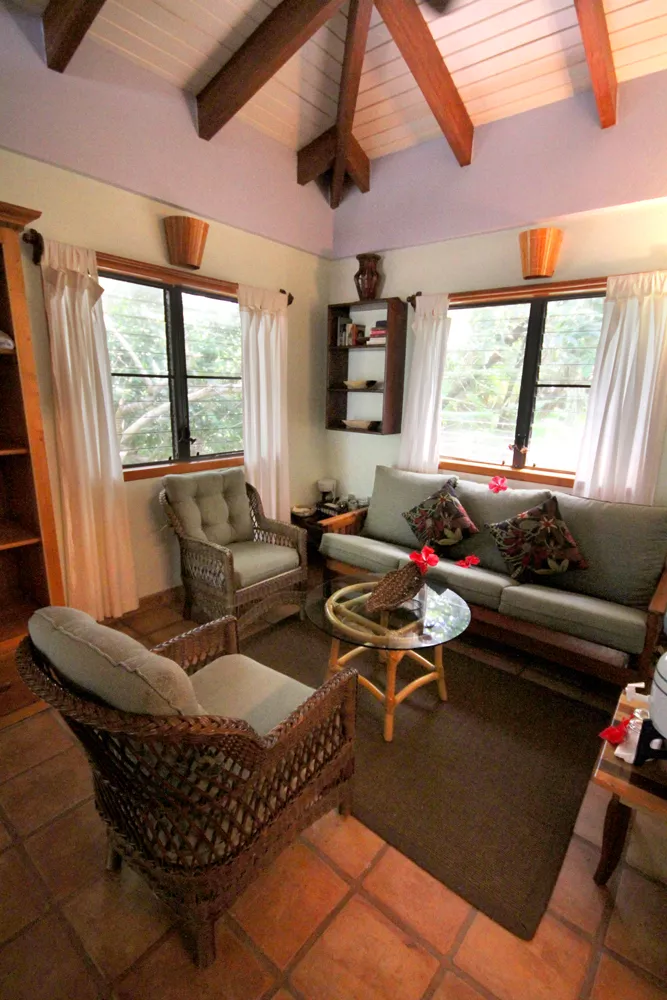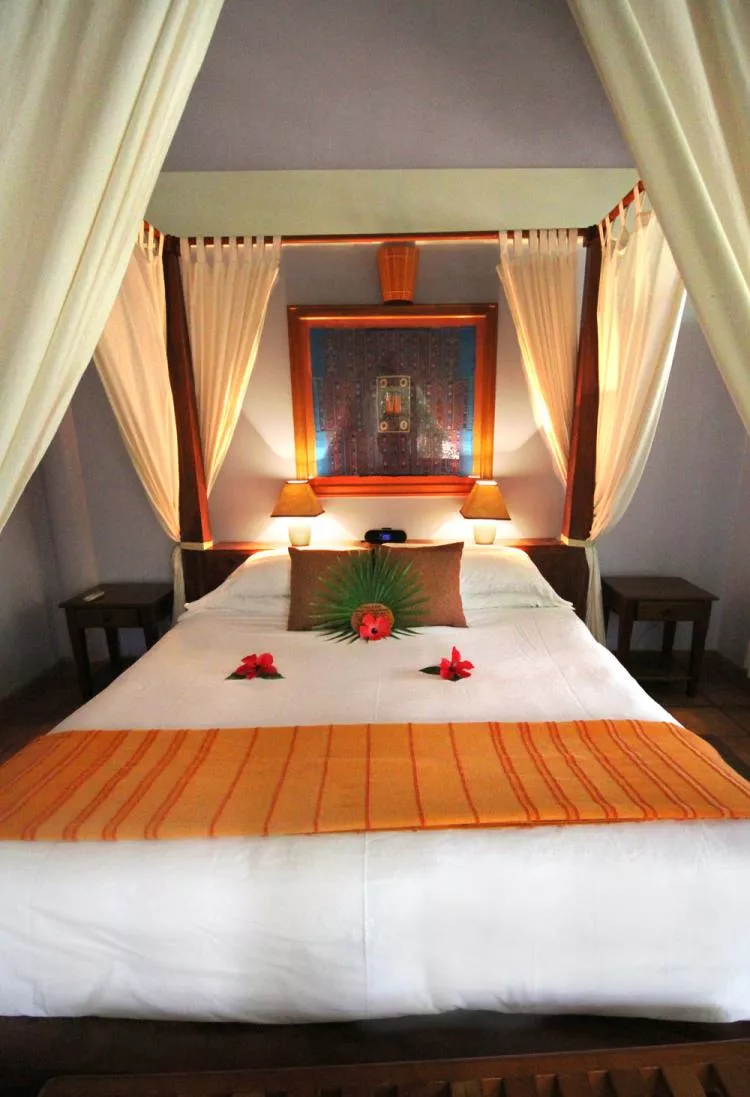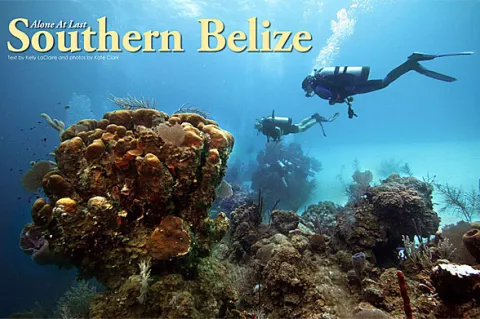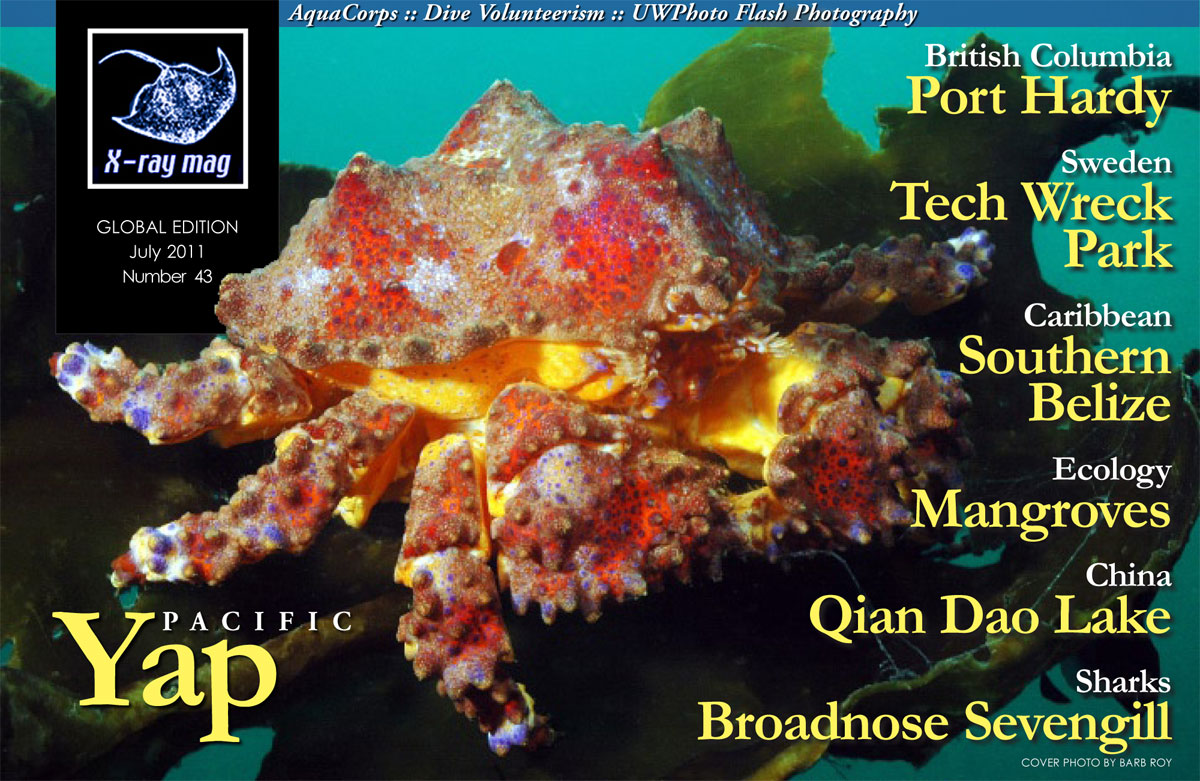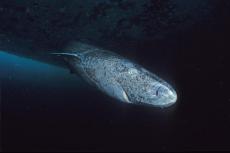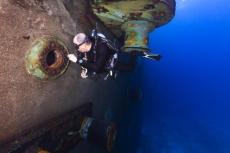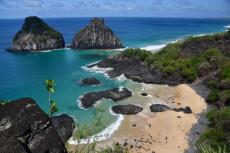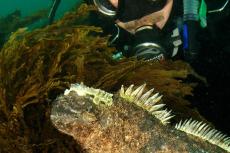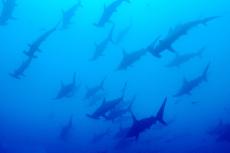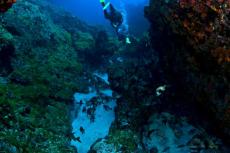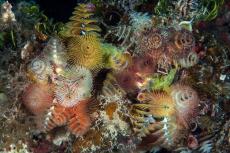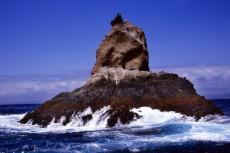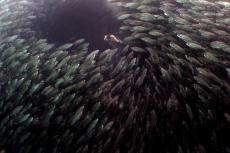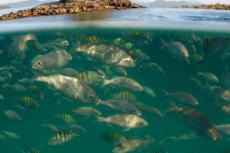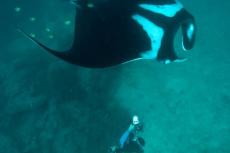Hello. My name is Kelly and I’m a dive-aholic. I freely admit it. I’m unabashedly, totally and completely addicted to travelling the world scuba diving. I love soaking up foreign cultures and engaging in lively conversations with friendly locals. I love sampling exotic foods that make your mouth sing and your stomach angry. I love taking that first giant stride into turquoise waters and discovering what new and fascinating critters await in the depths below. Heck, I even love the long and cramped, often overbooked and under-serviced flights one has to endure to reach these remote destinations.
Contributed by
But there is one thing I am not a fan of—and I’m pretty sure I’m not alone here—and that is the sagging, bitter disappointment I always feel when having to share my vacation with packs of people crowding every dive site and swarming each sight-seeing destination.
It’s not that I’m selfish— well, okay, maybe I am just a little— and it’s not that I don’t want fellow travellers to have great vacations and wonderful excursions for themselves, because I really do. They deserve it just as much as anyone else.
But let’s face it. Don’t we all yearn to show up at a world-class dive spot hardly anyone knows exists and get to explore it all by ourselves? Haven’t we all fantasized about laying a towel under a swaying palm along some deserted stretch of white sand beach and feel that blissful contentment of knowing you’ve got the whole place to yourself?
Haven’t each one of us stood in line with scores of other tourists waiting to see some natural wonder the guide-book promised was a “three-star, sight-seeing must” wondering, “What’s with all these people?”
You may be suffering under the delusion that all the great vacation destinations have already been discovered—that crowded dive sites, clogged beaches and endless lines are just a fact of life. Well, let me disabuse you of that idea here and now, loyal readers, because I have been to a place that defies even your grandest holiday wishes—Southern Belize.
Hopkins Village
Glover’s Reef Atoll. As I watched the gleaming white sands of the Hopkins shoreline grow fainter, my cousin and photographer, Kate Clark, said out loud what I was already thinking, “No one’s out on the beach yet—I guess they’re all still in bed.” She turned back around and stretched out on the large bow of our dive boat, soaking up the morning sun.
It takes about an hour and 20 minutes to reach Glover’s Atoll, an unspoiled ring of lush islands on the world’s second largest barrier reef, but we both considered this a plus. It gives you time to wake up and shake off the cobwebs of jet-lag (or the foggy-headed remains of too many drinks the night before) while getting to enjoy the gentle swells and soft breeze of the Caribbean.
When we arrived at the southwest wall—the first of three dives that day—our small group began stepping off the stern. As I awaited my turn, I scanned the flat sea, and I was surprised that we were the only boat in the area. C-Dog, one of our dive masters, had told me earlier that Glover’s was a popular site due to the pristine waters.
So, I was expecting other dive operators to be bringing groups out that morning. I thought briefly that our early start was the answer, and when we popped up, I would see several boats close by.
I took a giant step off the boat relishing the warm water and remarkable visibility. We dropped swiftly, levelling off and letting the mild current push us over the giant forest of purple sea fans, elkhorn, tube sponges and wire corals. Our dive master was right; Glover’s is absolutely teeming with life. A large school of black durgeons stopped circling a giant tube sponge to get a quick look at us but quickly realized we were no threat and went back to their never ending game of chase.
A pair of spiny lobsters twitched their tentacles nervously, trying to shove themselves further back into their hiding place as Kate moved closer for a picture or two. When she got the one she wanted, she took her reg out and flashed me a big smile, shaking her thumb and pinky at me, “This is so awesome!”
Rocky shelves and overhangs covered with red and green tube clusters dominated the seascape, and we immediately began searching for nurse sharks and morays. Neither showed themselves, but a curious hawksbill turtle came to greet us and inspected the glass on Kate’s housing before finding a spot to rest next to a glowing azure vase.
We slowly finned up a few meters and watched a pair of gray angelfish swimming in lazy, twisting loops around a group of star coral. They disturbed a sizable grouper that had his mouth open for a few tiny fish busily cleaning his teeth.
The current pushed us gently along the coral cliff for the next 20 minutes. Stoplight and butterfly fish darted in and out of craggy alcoves and a small school of barracuda eyed us with resentful suspicion.
I checked my air pressure and signalled to Kate that I needed to start ascending. She looked at her own gauge, still showing plenty of air left, and I could see no sign that she was exasperated by her time being cut short. In fact, Kate has been forever patient with my apparent lack of lung capacity, and I owe her a debt of gratitude that she never seems to hold it against me.
We surfaced after our safety stop and I immediately looked to see if any other boats had appeared. I was pleasantly surprised to find we were still alone on the water.
Long Caye Wall. Jacque Cousteau once said that the Long Caye site at Glover’s was one of his top-ten favorite dives. I would have to agree. It’s an easy dive with almost no current and shallow depths, so the colors are brilliant and vivid. As with all the waters of Belize, the visibility easily extends beyond 40 meters (120 ft) so keep an eye on your depth gauge.
At the top of the great wall, dozens of sandy cut-throughs leading in and out of towering coral heads can be explored and the site abounds with brightly colored fish, stingrays, eels, green turtles and nurse sharks.
At only 15 meters, we reached the brilliant white sand bottom and headed for the massive coral mounds marking the lip of the wall. A few divers swam through the tunnels in the rocky outcroppings while our dive master pointed out two adult spotted drums being swarmed by seven or eight tiny juveniles—their long, wispy fins fluttering. Two more hawksbill sea turtles made an appearance, and a lone hermit crab heading towards a sprawling field of sea grass was carving long, distinct, double tracks in the sand.
After 50 minutes, it was Kate that was pointing her thumb towards the surface, and I was stunned to find I had as much air left as she did. Back on the boat, sucking on Jolly Ranchers to get the salt out of our mouths, I couldn’t help myself. “You’re slipping in your old age, Miss Clark. Seems as if you may not be the breathing machine I always thought you were!” I went on this way for five minutes, grinning widely and feeling horribly proud of myself.
Finally, she could stand no more. “You know, I was trying to let you feel good about yourself,” she said. “But now, you’re just being completely obnoxious, so I’ll let you in on a little secret. My computer hose was leaking like crazy the whole time, and my tank was only filled to 2600 psi. Yours was at 3300, and you still came up with the same amount of air as I did.” She was standing over me at this point, and I was beginning to shrink under the onslaught. “So shut your trap, LaClaire, you’re still an air hog!”
Hamanasi Dive & Adventure Resort
It was mid-afternoon as we approached the long, sparkling beach of Hopkin’s village on our return from Glover’s, and I was amazed to see that the white sands were still empty. I turned to Kate, “This is spring break, right? I mean, I don’t have my dates wrong, do I?” She shook her head and smiled. “I love it here!”
We unloaded our gear provided by the operator—all of it high-end and in perfect condition—onto Hamanasi’s long dock and walked through the scattered palms lining the beach of the carefully tended property. If you’re unfamiliar with the resort, let me give you a brief introduction.
Named Belizean Hotel of the Year in 2009 and rated as one of the top ten hotels in the world by Trip Advisor, Hamanasi—meaning almond in traditional West African parlance—is a five-star, eco-friendly adventure lodge that has everything you could ask for. The quiet, secluded grounds are lush with native plant species, the rustic and charming tree-houses are replete with every imaginable amenity, and service takes on a whole new meaning here. Hamanasi’s motto is, “Bring the guests into our home and treat them like family. Deliver the vacation of a lifetime—no less!” It’s obvious they take that credo to heart, because the staff will do absolutely anything to make you happy.
We once tested this by asking Chef Sheridan Polanco for what is arguably the world’s best key-lime pie at 11pm—long after the kitchen was closed. We were brought out two plates and coffee within seconds. But it’s not just the visitors who are important, the resort takes it commitment to the local population seriously, hiring exclusively native Belizeans, donating supplies to local grammar schools and providing higher education scholarships. They are fiercely protective of the environment and dedicated to responsible, sustainable tourism.
Katrina, the concierge, had our guest house made up, and after we made ourselves comfortable, she took our dinner reservations and gave us a brief tour around the grounds. I asked her about the apparent lack of visitors and the empty beach. “It’s always like that here,” she replied. “It may not seem like it, but in fact the hotel is fully booked right now. Hopkins is a slow, quiet place, and that’s what we love about it.”
We spent the rest of the afternoon sitting by the pool, sipping cold Belikin beer and napping in the hammocks hung between the palms lining the empty beach. We had the place all to ourselves, and the only sound was the gentle surf breaking a few meters away.
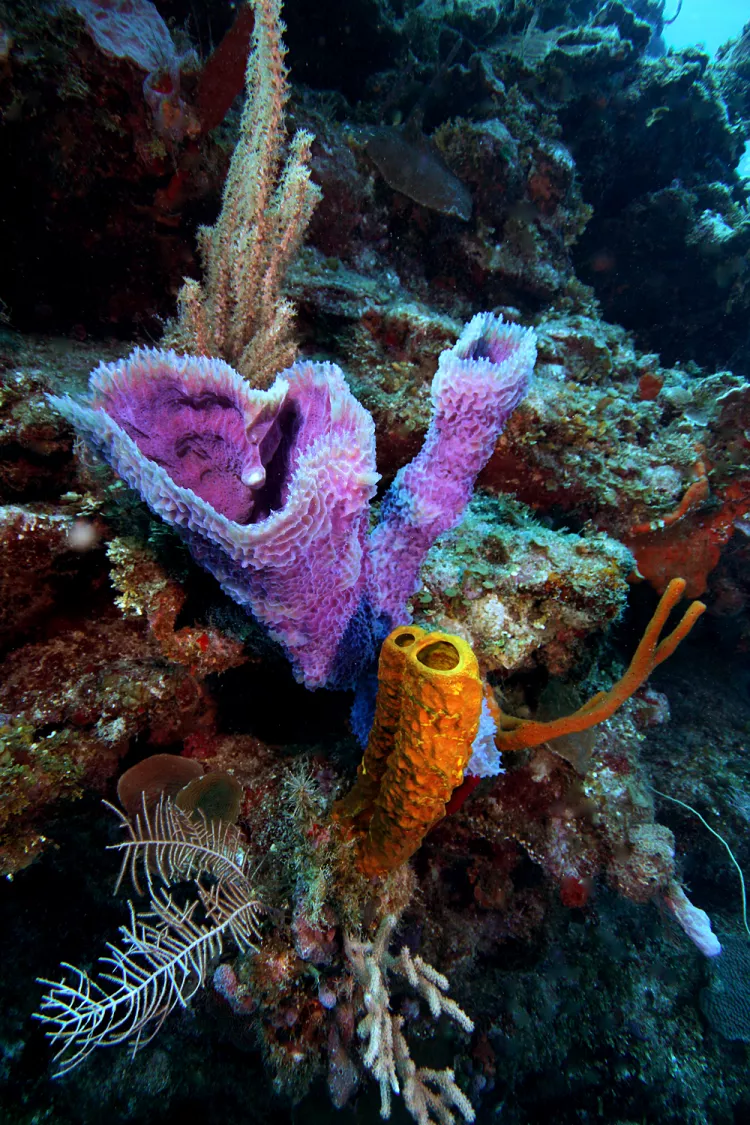
South Water Caye
The next morning, before leaving for South Water, we were treated to a tasty variety of fresh fruits, newly baked pastries and Hamanasi’s breakfast buffet of eggs, potatoes, bacon, coffee and juice.
The ride out to the reef was much shorter than the previous day, but we had plenty of time for sunbathing and a few conversations with several of the people who were joining us. This is one of my favorite parts about the scuba experience—meeting interesting people who have travelled the globe in search of blue water adventure. It’s always a pleasure to connect with someone from halfway across the world and compare notes on gear, dive locations, shark sightings and the fascinating similarities and differences of foreign customs.
Sam-I-am, another of our dive masters, called out the five minute warning, and we all began slipping into our wetsuits. Watching fellow divers ready themselves for upcoming dives is wonderfully exciting for me. You get to see adults suddenly become childlike with eagerness and enthusiasm for what’s to come. Life seems to pulse through them, and that contagious surge of emotion sweeps itself over the whole boat until everyone is absolutely giddy with the prospect of getting back in the water.
Jason’s Wall. Our fist site, Jason’s Wall, was nothing short of spectacular. Towering coral heads rise up like monoliths on the precipice of an imposing sheer face that falls more than 400 feet. We levelled off along the edge of the drop off, and a hulking Jew fish scowled at us, as we passed. Kate spotted a group of banded shrimp congregating on a sponge that would make Shaquille O’Neil look positively puny and paused to get a picture. Nearby, a grumpy looking eel brandished its teeth and lashed its tail back and forth warning us to stay away.
We let the current take us along the coral face, and soon we heard Sam-I-Am wrapping his tank. He pointed out a much larger and much friendlier green moray poking his head out of his den. He was easily two meters long (6ft), and Kate and I waited for the rest of the group to get a good look before we lagged behind to take a few photos.
As I watched her preparing for the shot, I found myself marvelling at the amount of skill and effort it requires to get a quality underwater image. Fighting the current, Kate had to set the shutter speed, change the light settings, manually situate her strobes and avoid scraping her knees and shins across the jagged corals below her—all this while keeping the twisting eel focused in the frame and not scaring the chary animal back into its hole. I realized that she had her wide-angle on, and I admit, I was more than a bit nervous when, after her equipment was set and ready, she got so close to the moray that the rounded glass dome of her housing was less than a centi-meter from its open mouth.
Later, as we sat on the bow feverishly telling each other how incredible the dive was, she showed me the moray eel shot on the LCD screen of her digital camera, and I hugged her effusively in congratulations. Then I told her if she ever got that close to one of things again, I’d take her camera away.
Our surface interval took place in South Water’s protected lagoon, and the crew cut up mango and watermelon for snacks. Just off the dock, Kate found an area of shallow water (only a few centimeters deep) where a small yellow stingray and three tiny black seahorses were foraging for food. While she put on her macro lens and checked her housing, I wandered the shoreline. There is a little resort on the island, but I only encountered one small group of college kids sunbathing and swimming. Further on, I came across a few snorkelers splashing along the reef that curls around the backside of the caye. Other than that, the island was empty, save a catamaran bobbing up and down in the cyan waters a few meters away. I sat down, digging my toes in the warm sand and took a large, satisfied breath.
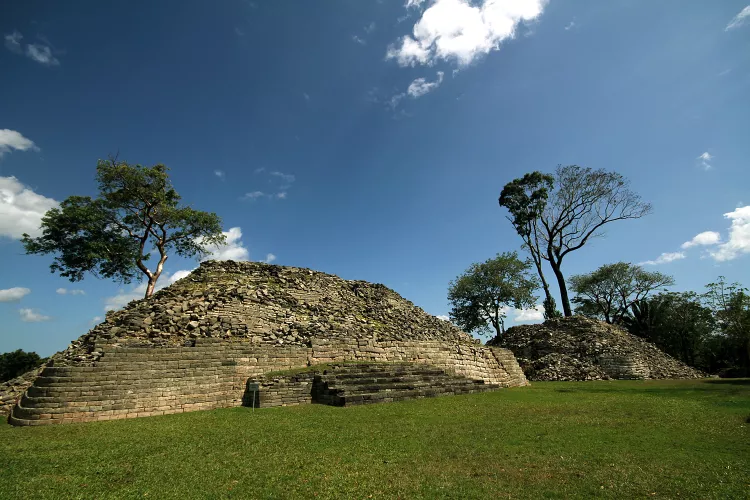
Jaguars, tapirs and snakes—oh my!
Less than 30 minutes drive from Hopkins village is the Cockscomb Basin Wildlife Sanctuary. Established in 1990 as the world’s first and only jaguar reserve, the dense jungles and rugged mountains of Cockscomb cover roughly 388 square kilometers (150 square miles). It is also home to the greatest density of jaguars in the world.
We arrived in mid-afternoon after a morning on the water to take a short hike and escape the heat. Kate and I were joined by two more of our cousins who had flown in the night before.
The ranger station provided us with a map of the basin’s trails, advising us to watch our steps and stay on the paths, as the rainforests of Belize are home to one of the deadliest snakes in the world—the Fer-de-Lance. If you’re bitten by one, you have 30 minutes to receive the anti-venom or the neurotoxin kills you.
We said a short prayer that none of us would encounter one and set off through the tangles of the reserve. The path we chose was a rather easy hike to one of the region’s many waterfalls, and en-route, we crossed paths with Belize’s national animal, the Baird’s tapir. He was young and small but quick, and we only got a quick glance of his small elephant-like trunk before he disappeared into the bush.
The sound of the river grew louder and louder as we continued on, and soon we came to a small waterfall that emptied into a large, clear pool surrounded by thick jungle foliage. We wasted no time jumping in.
The four of us swam under the falls for 20 or 30 minutes before discovering a group of natural waterslides eroded into the dark black river bed that swooped down in terraced sections. Perfectly smooth and concave, each stone chute is a few meters long and spills into a larger pool below creating an idyllic natural playground, just right for an afternoon cool down.
As we towelled off and put our shoes back on, Tracy summed up the day best. “I can’t believe we’re the only one’s here,” she said. “I mean, this place is amazing and no one seems to know it exists.”
Gladden Spit—Whale shark country
Forty miles south of Hopkins, at the end of a long peninsula, flanked by a giant lagoon on one side and the Caribbean on the other, you’ll find the bright and cheerful village of Placencia.
We arrived the first day of the full moon and were there to dive for a week searching for whale sharks with Seahorse Dive Shop. Started in 1992 by town dignitary and environmental champion, Brain Young Sr., Seahorse is world famous for pioneering whale shark diving in Belize.
Kate and I showed up at the dive shop with pastries for the crew from a local Swedish bakery. Mr. Young was preparing our boat, Deep Blue, and his oldest son, Brian Jr., helped us with our equipment. Sean Young, Brian’s middle son, greeted us affectionately in unintelligible Creole slang and loaded a cooler full of Belizean stew-chicken on board. I had heard of this dish and was assured Sean was a master at preparing it.
The ride out to Gladden Spit took over an hour. Doren, resident dive master at Seahorse, used the time to brief us on the area and how the dives would be structured. Once we reached the edge of the reef, he told us, the boat would sail out into the deep blue where giant schools of cubera snapper came to spawn in the days following the full moon. Brian Sr. would use sonar to find the school and, once over the top of it, we would get in and hover in a tight circle above the swarming fish. Our collective bubbles would simulate the spawning of the snapper and the release of their eggs, a principle source of food for the whale sharks. If there were any of the 20-ton fish nearby, they would come to investigate.
Kate and I were beyond excited. Many divers classify a whale shark sighting as the Holy Grail of diving, and we are no exception. Once we crossed the outer reef and entered the large, heaving swells of the open ocean the boat was immediately tossed back and forth in great listing yaws. A couple snorkellers who had joined us couldn’t take it and spent the rest of the afternoon vomiting over the rails. After ten minutes of searching Brian Sr. yelled out from the captain’s chair, and we all jumped in as fast as possible.
It’s a strange sensation diving in the open ocean. You have no frame of reference, and you’re totally surrounded by an endless expanse of blue stretching to infinity in every direction. We descended rapidly, trying to get below the swells and not wanting to lose the snapper.
Doren tapped his tank, beckoning us to follow, and off we went, down and down into the emptiness. After a few minutes of searching, Doren pointed out the silhouettes of thousands of twisting and slashing fish about 15 meters below us. We had been instructed to level off at 22 meters (70ft) and under no circumstances were we to drop below 25 (80ft)—that would only push the school down deeper and end our dive.
As we hovered, the immense group of fish began to ascend, and soon we were only a few meters above them.
Cuberas, I realized, are big fish, easily over a meter (3ft) in length and weighing close to 25 kilos (40 lbs). We followed them for quite awhile, as they drifted along, and soon we were joined by a second school—this one made up of several hundred horse-eye jacks.
The bright silver jacks seemed fairly inquisitive and surrounded our small group of divers, circling us in a spiralling column rising towards the surface. For a moment, I forgot about the snapper, but a large shifting shadow below caught my eye, and I turned back towards the cubera.
Three bull sharks, thick and lethal, cruised through the center of the school. My heart began thudding rapidly in my chest, my breathing involuntarily quickening. I’d never seen bull sharks before, and I’m not ashamed to admit I was a bit frightened. I could feel my body galvanize with adrenalin, and I grabbed Kate’s arm, pointing at the three fierce-looking sharks. She nodded slowly, enraptured by them. I took a few deep breaths to slow my heart. It calmed me some to watch them move carelessly among the snapper, recognizing that these bulls were not concerned with us.
After 40 minutes, Doren signaled the end of the dive, and we headed up. No whale sharks today.
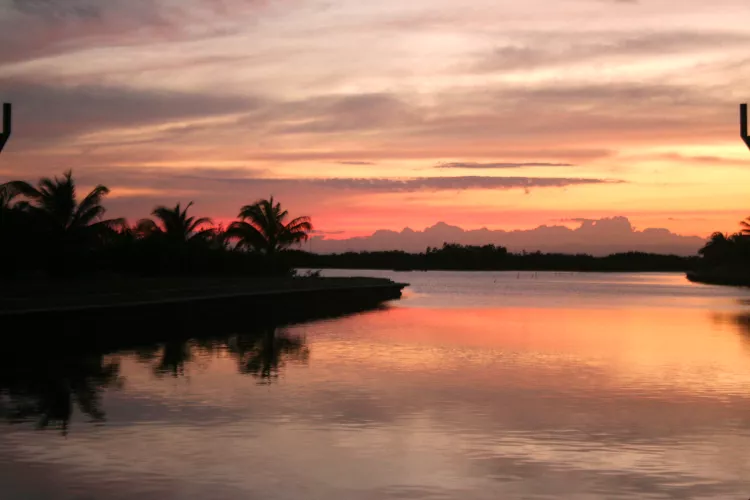
Placencia—Crown Jewel of Southern Belize
I’m not sure what it is exactly, but Placencia stole a piece of my heart. There is something indescribable about the whole place that seems to seep into your bones and radiate through your soul. No matter what we were doing or who we were with, I found myself not wanting to leave.
The locals are friendly, laid-back and personify the word, chill. The village itself is dominated by colorful clapboard houses, locally owned guest houses and beach side eateries, our favorites being the Tipsy Tuna and the Barefoot Beach Bar. Placencia also boasts some of the best beaches in the country, and you’ll be hard pressed to find more than a handful of people on any of them.
The village is a perfect “base camp” for visiting Southern Belize as inexpensive puddle jumpers fly in and out regularly from Belize City, and now that a brand new highway has been completed, it is easier than ever to get to. We had planned a couple of inland
adventures between diving days to check out what Southern Belize had to offer and, believe me, it does not disappoint.
Our first excursion took us less than an hour away to a Mayan ruin that our guide book dismissed as “unremarkable”. Factually, I think the author must have been dropped on his head as a child, or maybe he was ridiculously hung-over when he visited, because the partially reconstructed sight of Lubaantun is absolutely breathtaking. This site is easily accessible by car, and despite the slightly smaller size, it’s still very worth a visit and should not be missed.
After a short tour of the visitor’s center, the four of us hiked among the towering rock structures and crumbling ruins, marveling at the complexity of the site. It was hard for me to wrap my mind around the precise mathematical symmetry used to build each structure. The amount of physical labor it took to construct the city was baffling.
We met a small group of Belizeans in sweat-soaked khakis who worked for the archeological society, hacking back the ever encroaching jungle with nothing more than a few machetes. They were obviously hot and tired but seemed more than happy to stop and talk with us about Mayan culture and the various architectural aspects of the site. Lubaantun, they told us, is only one of two known sites in the Mayan world where all the rocks used in construction were smoothed down to have rounded shaped edges. No one knows why this was done.
I would like to have stayed there the rest of the day, exploring the ancient city’s nooks and crannies, getting lost in its history, but the sun was beginning to sink and we wanted to get to our next destination before sundown.
As we were leaving Lubaantun, I looked back at the stone pyramids and green fields, counting the other visitors. I only saw one.
A short drive later we arrived at Blue Creek, named for the river that runs through the village. A few ladies lined the road selling Mayan trinkets and baskets while others sat on boulders in the creek washing clothes with stones. We set off on a clearly marked trail that follows the river and weaves its way through the trees and vines for about a half mile before it ends at the mouth of a stunning six-story cave.
After we swam in the pool at the cave’s entrance, we pulled out our dive lights and gave three local kids five dollars each to take us spelunking into the black depths of the giant cavern. Cave systems like these are ubiquitous in Belize and spelunking is a popular sport with locals and visitors alike.
Our adolescent tour guides told us that Blue Creek cave extends back for over six miles, and that if you go back far enough, you’ll find an underground waterfall that crashes out of the ceiling of the cavern. Thirty minutes in the spooky black interior was long enough for us, and we decided to turn back.
Outside, the sun was setting, and we got in another swim before a few swooping bats that had come out to hunt chased us out of the water and back towards our car.
Guess how many tourists we saw.
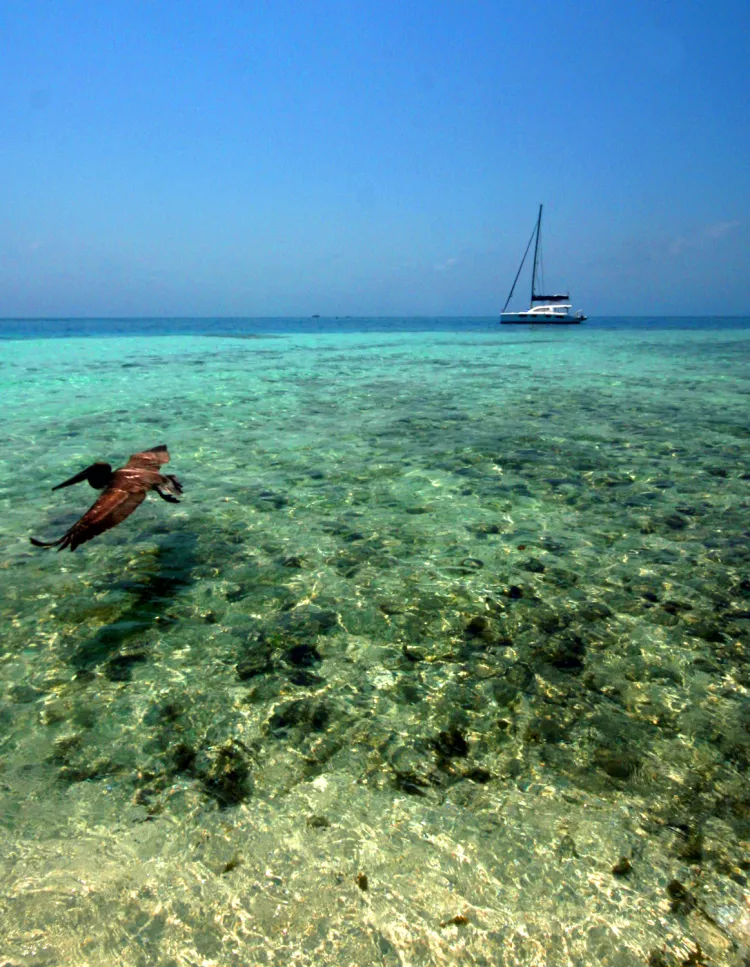
Silk Cayes
We spent three frustrating days in search of the world’s largest fish, but Mother Nature is often fickle, and the whale sharks never made an appearance. Kate was getting restless. So far, she had very little opportunity to get some macro shots. So the crew at Seahorse took us out to a string of deserted islands known as the Silk Cayes where the reefs are rich and vibrant even at considerable depths. Perhaps the sea life there felt sorry for our previous days of fruitless searching because they came out in force. Turtles, eagle rays, eels, countless species of fish and a solitary reef shark all came to say hello. It was as if we brought along a diver’s bucket list and got to check off nearly every item on it in one spectacular dive.
We ate homemade barbecue and fresh tuna salad under the shade of palms while watching a family of pelicans swoop and dive for fish at the island’s edge. A group of three friendly and playful dolphins had come to investigate the small group of snorklers who were with us, and they were laughing about the experience while sitting in the sand.
Before we left for the day, our little boat stopped at a location I have sworn to keep secret. As we approached, I saw an old wooden boat bobbing up and down—its crew a group of leathery-skinned free divers cleaning the day’s catch. Our group slipped into the water with just our snorkel gear and were treated to the best deco stop ever. Two giant loggerheads were sparring under the bow for conch scraps, and three or four spotted eagle rays slowly circled the stern waiting for their chance. Several large sting rays fluttered along the grassy seas bed, and a blacktip reef shark, followed by three nurse sharks came to investigate the free meal of fish offal being thrown overboard. It was the best snorkel dive of my life. Had that been our only time in the water, our entire trip would have been worth it.
On the ride back to Placencia, Carleton Young (aka “Patu”)—Brian Sr.’s brother and part owner of Seahorse—handed Kate and I an ice cold Belikin and toasted our visit. He invited us to come back next spring break for a diving trip though the Cayes and down into Panama aboard a catamaran he charters called the Wild Orchid.
“Geeze, Carleton,” I said smiling, “We’ll need to think about that. I mean, we had planned a whole rain-filled weekend of diving in the freezing Puget Sound with 30 other divers and two scuba classes. It’s gonna break my heart to have to give up the double 60mm wetsuit I usually shove myself into to keep my heart from stopping, just to come back here.”
“I guess that makes sense,” he laughed, sweeping his hand towards the empty sea. “It’s pretty awful out here—and the crowds here are pretty hard to put up with.” ■
Kelly LaClaire is a dive writer based in Portland, Oregon, and his cousin, Kate Clark, is an underwater photographer from the same city. They travel as a team to cover dive locations in the Americas, the Caribbean and the Pacific.
Published in
- Log in to post comments

